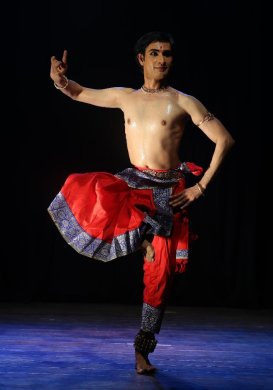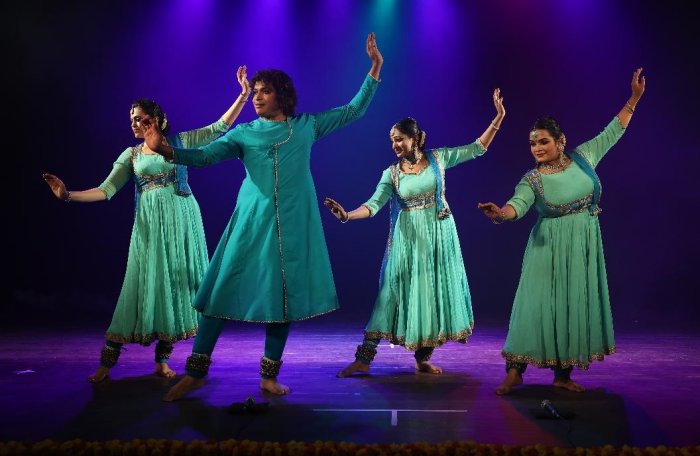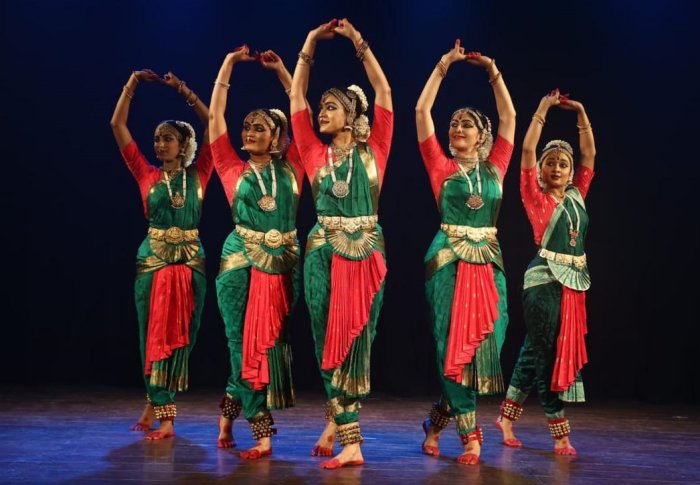
|   |

|   |
Kavi Pranamam - Tapati Chowdhurie e-mail: tapatichow@yahoo.co.in December 21, 2022 Kim Aham, the school of Indian classical dance, presented Kavi Pranamam in Seva Sadan, Bangalore, recently. As the title suggests, obeisance was paid to poets from medieval to contemporary times of India.  Avijit Das In the short span of a decade, Avijit has established himself as a Kuchipudi dancer of repute. BWW review of Erasing Border Festival of Indian Dance by Juan Michael Porter II says that his dance "transports the audience to a higher plane." "Mr. Das has more attack, more hunger. Nobody ate up space so eagerly or in more staggeringly non-stop sequences…..the alternation of nritta and abhinaya in his work is subtle," wrote Alastair Macaulay about Avijit. He himself performed Abhinaya Vibhava, which is an adaptation of the Natyaarambham slokams of Natyasastra of Bharat Muni, which were meant to be recited before commencing to dance. It also spells out what is to be done every day before classes and is about correct postures essential to pursue the art of dance. This piece translated into Telugu by Narayana Sastry composed by Rajkumar Bharati in ragamalika and talamalika was educative for the lay audience. Namavali Kandarpa Janaka Garuda Gamana written by Tallapaka Annamacharya set to ragam Valachi and talam adi to a composition of Voleti Venkateswarlu, courtesy Natya Keertanam by Sampada Silicon Andhra University was the next piece, set in pure dance drama segments. The dance piece was composed and choreographed by Avijit Das. His well-trained disciples Shweta and Madhulita who are in their peak form accompanied him. The trio's performance was electrical as they traversed the length and breadth of the stage with the Kuchipudi form totally in their grip. There was magic in their movements and the aura of their performance pervaded through the hall. The yearning of the mortal soul for union with the immortal symbolized with the hankering of the nayika for her beloved was aesthetically etched in the vocabulary of Kuchipudi dance.  Chintan Patel Chintan Patel trained in the Kalakshetra bani of Bharatnatyam was at his best in Kharaharapriya varnam of Dandayudhapani Pillai,"Mohamaginen inda velayil". Starting from the salutation of the nayika to Vishnu, this gem of a piece described the attributes of Vishnu in all his glory, the Absolute and the liberator. The nayika sought liberation from all bonds. Narayana Hari, one who sleeps in the ocean and one who has a lotus in the navel was venerated. To describe the two different aspects of Lord Venkateswara such as the pangs of the wives of Kaliya serpent and his friendship with Arjuna, the valorous one, in the pristine Bharatanatyam genre sure needed practice to gain the appreciation Chintan received from the audience. Manmadha's torments with his 5 arrows made of flowers - Aravinda, Ashoka, Choota, Navamallika, and Neelotpala - intensifying the nayika's love was uniquely described by the male dancer. Bhakti sringar visualized by the poet as the intense love of the nayika for her lord is the concept of the song and Chintan Patel successfully relayed this kind of true love. Surrender can offer an invitation to embrace life more fully by deepening our trust and awakening our sense of acceptance. Surrender might mean an invitation to embrace what is, to let go of resistance, to stay open for exciting potential outcomes to unfold. Exactly how it feels when you are in love. The piece was taken from the album Aavaahanam.  Hari, Chethana and group Kathak dancers Hari and Chethana presented "Jeevo Jeevasya Jeevanam." They used verses from Kannada poet K.S. Narasimha Swamy, which is about the philosophy of life, relationships and nature. The dancers bowed to the magical and illusory universe which dwelt in total darkness. The dancers went on to picturize his poetry with the metaphor of the constellation and sky watching the sea. The poet's urge to nature and all its beauty to blossom the emotion of love in all living things was translated evocatively in the language of dance. Asking the peacock to spread its emerald feathers to shine and augur all that is good and noble was aesthetically done. The technical intricacies of the Kathak idiom added flavour to the work of the poet rendered to the composition of Raghunandan Ramakrishna - sung and performed by Supriya Raghunandan, Chethana, Hari, Diya, Sirisha, Varuni and Nidhika. Visualizing an abstract poem and presenting it in dance form needed a lot of imagination and the choreographers emerged glorious in presenting it in the Kathak style.  Disciples of Sathyanarayana Raju The Samskruthi Ensemble presented Maharaja Swati Tirunal's magnum opus "Bhavayami Raghuramam". The whole of Valmiki's Ramayana has been written in this verse . Bharatanatyam exponent Sathyanarayana Raju's disciples are a set of well-trained dancers and they commended themselves well in the absence of their guru. This speaks volumes about the mentor's grooming. Curated with care by Avijit Das, the evening was delightful.  Tapati Chowdhurie trained under Guru Gopinath in Madras and was briefly with International Centre for Kathakali in New Delhi. Presently, she is a freelance writer on the performing arts. |